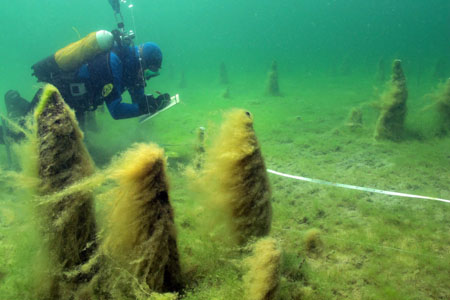Bronze Age sites in littoral contexts and their relation with the hinterland
International Conference
Decentralised Société préhistorique française conference organised in collaboration with the Association pour la Promotion des Recherches sur l’Âge du Bronze

The shorelines of lakes, lagoons, rivers as well as estuaries and coastal fringes – were particularly attractive to the Bronze Age communities of Western Europe. However, they do not seem to have been occupied continually and show evidence of various types of installations, settlements or sites specializing in the exploitation of these biotopes. The specificities of these wetland or submerged sites, from the excavation techniques to the structures and the materials unearthed, come together in a totally separate discipline, which does not encourage direct comparison with "terrestrial" sites. The aim of this symposium is therefore to bring together different approaches to the study of sites located in these interface zones between land and water, to reflect on their specificities and their relationship with other occupations situated in the "hinterland". There are two main themes:
1. Incentives and form of littoral occupations
The insalubrious nature of wetlands, coupled with the possible exposure to infectious diseases such as malaria, is so deeply rooted in common thinking that these types of places are sometimes considered marginal. Some of the ethnological and historical data illustrates the factors of constraint that govern the colonization of wetlands, such as overpopulation or the territorial pressure that follows conflicts. Nevertheless, wetlands and shorelines are attractive ecological niches, rich in resources, especially fisheries. At the interface of compatible environments, they offer a great economic potential. During the Bronze Age, where there is strong evidence for navigation, the organization and the control of trade, sometimes over long distances, could also be a factor in the occupation of these zones which open out onto natural communication channels.
By analyzing the form, and the location as well as the economy of the sites and at the same time comparing them to the historical and cultural phenomena which have been brought to light for the Bronze Age, the objective is to identify models and to identify regional specificities. The priority will be given to multidisciplinary research, combining the analysis of material culture and bioarchaeological data preserved on waterlogged sites. In these interface zones, the evolution of the environment is particularly perceptible, with the upwelling of marine waters or lakes, the aggradation of deltas and the erosion of coastlines. Geomorphological and paleoenvironmental approaches are also encouraged and can be the subject of specific presentations. Thus, the determining role of climate change on human settlements, for which alpine lakes are a case study, will have to be discussed, especially in relation to other European regions.
2. “Gens de l’eau, gens de la terre“: relationships between shoreline sites and the hinterland
This title, borrowed from P. Pétrequin, emphasizes the dichotomy that exists between the communities inhabiting the coasts and the hinterland, for which there are many ethnographic examples. Based on material culture, this distinction between communities is a topic open for debate. Similarly, the economic specificities of these sites, which exploit biotopes of a different nature, can also be alluded to. Beyond that, it is also the interdependence of these shoreline and hinterland sites that can be questioned. Were settlements self-sufficient or were they part of a network, a dependency, even a hierarchy? This multiscale analysis needs to look at similar geographical groups, but also examine evidence at a microregional or even a regional scale. The theme also raises the question of the existence of specialized or seasonal sites linked to a particular craft or subsistence activity, such as fishing.
This symposium is open to all archaeologists, bioarchaeologists, geomorphologists or paleoenvironmentalists working on the question of Bronze Age occupations in littoral contexts, on submerged or on land sites, but also on hinterland settlements. The geographic framework chosen is that of Western Europe.
